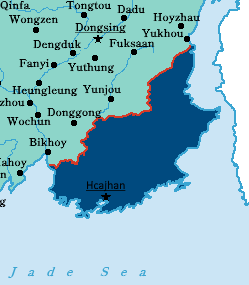Pyinthar: Difference between revisions
Posadastan (talk | contribs) |
Posadastan (talk | contribs) |
||
| Line 138: | Line 138: | ||
====Civil Conflict==== | ====Civil Conflict==== | ||
==Geography== | |||
==Government and Politics== | |||
==Economy== | |||
==Demographics== | |||
==Culture== | |||
{{Teleon}} | {{Teleon}} | ||
Revision as of 15:26, 15 August 2024
This article is incomplete because it is pending further input from participants, or it is a work-in-progress by one author. Please comment on this article's talk page to share your input, comments and questions. Note: To contribute to this article, you may need to seek help from the author(s) of this page. |
People's Republic of Pyinthar | |
|---|---|
| Anthem: ကမ္ဘာမကျေ Kaba Ma Kyei "Till the End of the World" | |
 Location of Pyinthar in Abaria | |
 Subdivisional map of Pyinthar | |
| Capital and largest city | Hcajhan |
| Official languages | Pyinthari |
| Recognised regional languages | Thanhliênese Lanhsavanian |
| Ethnic groups (2022) | 62.8% Pyinthari 21.4% Thanhliênese 7.1% Lanhsavanian 5.6% Mylasian 2.6% Yinese 0.5% Other |
| Religion (2022) | 81.2% No religion 6.8% Gregorianism 4.7% Himayan 2.4% Sendou 4% Other |
| Demonym(s) | Pyinthari |
| Government | Unitary Arvidsenist one-party socialist republic under a totalitarian military junta |
• Chairman | Hla Htay |
| Moe Thiri | |
• Premier | Zaw Lin |
| Legislature | People's Assembly |
| History | |
| c. 200 BCE | |
| c. 1350 | |
| July 1758 | |
| 1 August 1899 | |
| 18 September 1941 | |
| 13 April 1968 | |
| Area | |
• Total | 443,322.5 km2 (171,167.8 sq mi) |
• Water (%) | 3.0 |
| Population | |
• 2022 estimate | |
• Density | 217.47/km2 (563.2/sq mi) |
| GDP (PPP) | 2022 estimate |
• Total | |
• Per capita | |
| GDP (nominal) | 2022 estimate |
• Total | |
• Per capita | |
| Gini (2022) | medium |
| HDI (2022) | medium |
| Currency | Shwé (ရွှေ/Ꞩ, PYS) |
| Time zone | UTC-5 (Pyinthari Standard Time, PST) |
| Date format | dd-mm-yyyy |
| Driving side | right |
| Calling code | +68 |
| Internet TLD | .py |
Pyinthar (Pyinthari: ပြိန်ထရ; PLCTS: Pyain-ṭhar; [pjɪ̀ɰ̃.tʰa̰]), officially the People's Republic of Pyinthar (Pyinthari: ပြည်သူ့ သမ္မတနိုင်ငံ ပြိန်ထရ; PLCTS: Pyi Thu Samma Da Nain Ngan Pyain-ṭhar), is a sovereign state located in Western Abaria. It shares its only land border with Yingok to the west and its other close neighbors are X and X to the east, with the Jade Sea being located along most of the coastline. It is the second largest country by area in Mainland Western Abaria and has a population of about 96 million. The country's capital and largest city is Hcajhan.
Early civilizations in the area stemmed from the immigration of southern Yinese people between 1500 and 1000 BCE. These later developed into more sedentary societies that included the Pyinthari- and Thanhliênese-speaking city-states, many of which arose around the 2nd century BCE. These city-states persisted until around the 9th century CE when many formed various regional confederations, in a period known as the Three Kingdoms Period. Following the establishment of the Hcajhan Kingdom around 1050 CE, the Pyinthari culture, language and religions became the dominant forms within the region. The Hcajhan Kingdom fell to the Artuchids around the late 13th century, where it was later replaced by the 2nd Three Kingdoms Period, with the kingdoms of Kathaiwabha, Daghein, and Thiênh (from west to east respectively). By the 16th century, the Kathaiwabha had subsumed the two others, forming the Taungumein Kingdom, which reunified most of what had been under the domain of the Hcajhan Kingdom earlier on. After a brief war against Yingok the Taungumein Kingdom collapsed, giving way to the Gyadhao Kingdom in 1758, which formed the modern borders and culture of Pyinthar.
TBD
Etymology
The etymology of the word "Pyinthar" is believed to be derived from the ancient Pyinthari words Pyin (ပြိန်) and Thar (ထရ). Pyin suggested a sort of connection, union, or harmony, with Thar implying a further sense of grandeur or significance. Over time, it is believed that these two words conjoined into some vague "Land/People of Harmony," though this particular etymology is disputed.
Alternatively, others have interpreted it as meaning "the noble homeland" or just "the homeland," as the actual definition of each constituent word being difficult to trace and translate. However, most scholarly debates focus more so on the former etymology, seeing as how the term is used for the nation and its people.
History
Prehistory
Pyinthari City-States
Thanhliên Kingdom
1st Three Kingdoms Period
Hcajhan Kingdom
Artuchid Invasions
2nd Three Kingdoms Period
Kathaiwabha and Taungumein Kingdoms
Taungumein-Yingok War
Gyadhao Kingdom
Industrial Revolution
1st Civil War
Republic of Pyinthar
2nd Civil War
People's Republic of Pyinthar
1968 Coup d'état
Civil Conflict
Geography
Government and Politics

